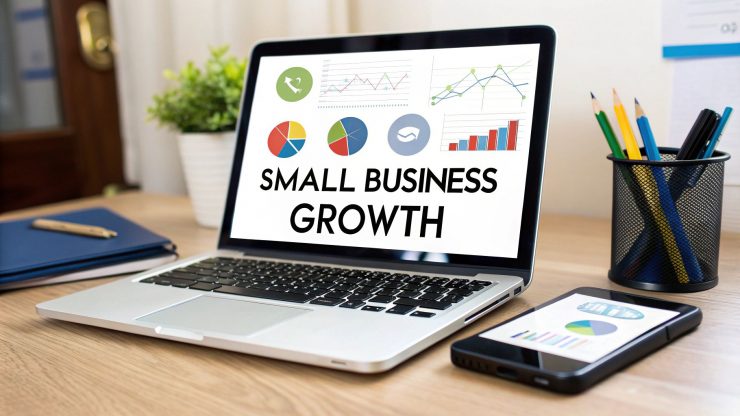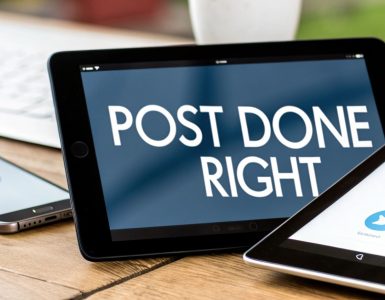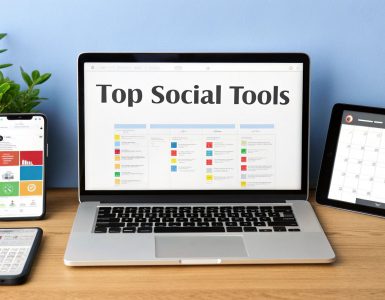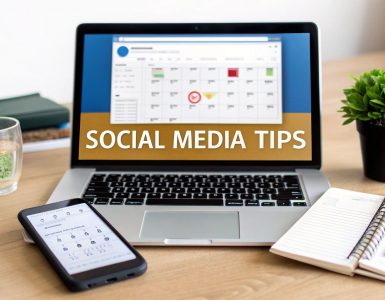A solid digital marketing strategy for a small business isn't some complicated, fifty-page document. It's simply a focused plan that connects your big-picture business goals to specific online actions. It’s about figuring out who you’re trying to reach, picking a couple of key places online to find them (like local search and one social media platform), and then showing up there consistently with helpful content.
The secret sauce is clarity and focus. You don't have to be everywhere at once.
Your Small Business Digital Marketing Blueprint
Let's be real—digital marketing can feel like trying to drink from a firehose. Between SEO, social media, email, and a dozen other things, it's easy for small business owners to feel completely overwhelmed. You end up throwing time and money at different tactics, hoping something sticks. This guide is here to cut through all that noise.
You don't need a massive budget or a full-time marketing team to make a real impact. An effective digital marketing strategy for small businesses is built on a simple, focused blueprint. It's about making smart, deliberate choices and then executing them consistently, not chasing after every shiny new object.
This process chart really breaks down the foundational flow, showing you how to build your strategy from the inside out.
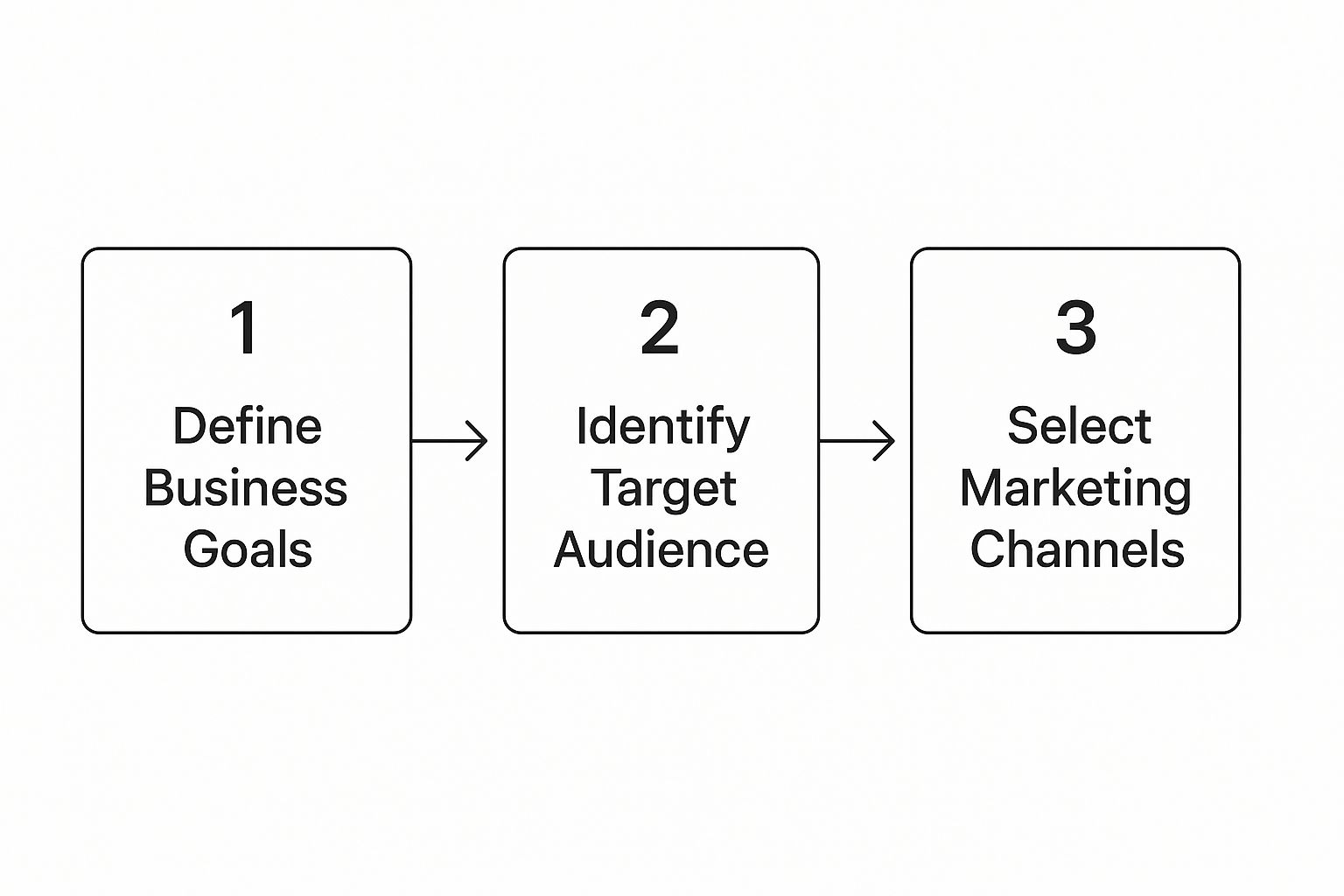
As you can see, a winning plan always starts with what you want to achieve—your goals—long before you start thinking about customers or marketing channels.
The Core Pillars of a Winning Strategy
To get this right, we're not just making a random to-do list. We’re building a roadmap where every step logically follows the last. This approach saves you a ton of time and ensures every single thing you do has a clear purpose.
Here's a quick look at the core framework we'll be diving into throughout this guide.
| Phase | Objective | Key Activities |
|---|---|---|
| 1. Goal Setting | Establish clear, measurable business outcomes. | Define SMART goals (e.g., increase online bookings by 15%). |
| 2. Audience Definition | Deeply understand your ideal customer. | Create a detailed customer persona, including pain points and habits. |
| 3. Channel Selection | Focus resources on high-impact platforms. | Choose 2-3 channels where your audience is most active (e.g., Google, Facebook). |
| 4. Content Planning | Create a system for producing valuable content. | Develop a content calendar with topics that address audience needs. |
| 5. Measurement & Iteration | Track performance and optimize for results. | Monitor key metrics (e.g., website traffic, lead conversions) and adjust. |
This table lays out the fundamental building blocks. Get these five things right, and you're well on your way to a strategy that actually works.
The biggest mistake I see is business owners jumping straight to tactics—like boosting a post on Instagram or running a Google Ad—without a strategy. It's like trying to build a house without a blueprint. You might get a wall up, but it's probably not going to stand for long.
From Overwhelmed to Empowered
This whole blueprint is designed to be practical. You don't need to become a digital marketing guru overnight.
The real goal is to build a sustainable system that consistently attracts the right kind of customers and drives real growth for your business. By focusing on these core components, you can create a plan that is both powerful and manageable, even when you're short on time and resources. Each section of this guide will walk you through the actionable steps to build out your own customized strategy.
Define Your Goals and Ideal Customer

Before you spend a single dollar or a single minute on marketing, you need to get crystal clear on two things: what you actually want to achieve, and who you’re trying to reach. I've seen countless small businesses jump straight into running ads or posting on social media without this foundation, and it's the fastest way to burn through your budget with nothing to show for it. Any effective digital marketing strategy for small businesses starts with a destination in mind.
Vague goals like "get more customers" or "increase sales" are useless. They feel good to say, but they're not actionable. They don't give you a target to aim for, which makes it impossible to know if your efforts are even working. What you need are specific, measurable objectives that tie directly back to the health of your business.
Let’s think about a local bakery. Their goal isn't just to "sell more cakes." A much stronger, more powerful goal is to "increase online pre-orders for custom cakes by 15% within the next quarter." See the difference? This target is specific, measurable, and has a deadline, giving the bakery a clear benchmark for success.
Setting Goals That Actually Matter
To set goals that will drive real growth, you have to think about what success truly looks like for your business in the next three, six, or twelve months. Is it more people walking through the door? A higher average order value? More subscribers on your email list? Each of these requires a completely different marketing approach.
Here are a few real-world examples to get you thinking:
- A local plumber: Increase online bookings for emergency services by 20% over the next six months.
- An independent bookstore: Grow the email newsletter list by 500 subscribers before the holiday season kicks in.
- A freelance graphic designer: Secure three new retainer clients through LinkedIn outreach in Q4.
A goal without a number is just a dream. Attaching a specific metric and a deadline transforms a vague wish into a concrete plan of action. This is the difference between hoping for growth and actively engineering it.
This process forces you to be both realistic and focused. Once you have a clear goal, every marketing decision you make becomes simpler. You can ask yourself, "Will this action get me closer to increasing my online bookings by 20%?" If the answer is no, you can confidently move on to something that will. This is a fundamental step, and you can learn more about its importance by reading this beginner's guide to digital marketing.
Crafting Your Ideal Customer Persona
Okay, so you know your destination. Now you need to figure out who you’re taking on the journey with you. Trying to market to "everyone" is a surefire way to connect with no one. This is where creating a customer persona—a detailed profile of your ideal buyer—is an absolute game-changer.
A persona isn't just a list of demographic data. It's a story about a real person, complete with their own challenges, motivations, and daily habits. Your job is to understand them so well that you know exactly what they need and where they hang out online.
Start by looking at your current best customers. Who are they really?
- What are the pain points that your product or service solves for them?
- Which social media platforms do they actually use, not just the ones you think they use?
- What kind of content do they find valuable, funny, or interesting?
To really nail this, you should dig into the nuances of customer segmentation best practices. This helps you group similar customers together so your message can be that much more targeted and effective.
Bringing Your Persona to Life
You can gather this information from simple surveys, by digging into your social media analytics, or just by having direct conversations with people. Let’s build a quick persona for our local bakery example.
Persona Example: "Celebration Sarah"
- Demographics: 30-45 years old, lives within a 10-mile radius of the bakery, is a working parent.
- Pain Points: She’s strapped for time and wants high-quality, memorable cakes for family events, but has zero time to bake. She also worries about finding a reliable, local option online that won't let her down.
- Motivations: She values convenience, quality ingredients, and creating special memories for her family.
- Online Habits: She’s active on Instagram and Facebook, is part of a few local parent groups, and always checks Google reviews before making a purchase.
Just like that, the bakery now knows exactly who they’re talking to. Every piece of content, every ad, and every social media post can be crafted with "Celebration Sarah" in mind. This kind of laser-focused approach ensures your marketing message hits home, making every bit of effort more efficient and powerful.
Choosing Where to Plant Your Flag
When you're running a small business, one of the biggest mistakes you can make is trying to be everywhere at once. You see your competitors on TikTok, LinkedIn, and running Google Ads, and the pressure mounts. You feel like you have to do it all.
Don't fall into that trap.
Spreading your limited time and budget too thin is a recipe for getting zero results everywhere. A smart digital marketing strategy isn't about casting the widest net; it's about finding the right fishing spot and using the best bait.
The whole point is to go deep on the one or two channels where your ideal customer—that persona we just sketched out—actually lives and breathes online. It's far better to be a big deal on one platform than a forgotten whisper on five. We're going to focus on the powerhouse trio that consistently delivers for most small businesses: Local SEO, a highly focused social media presence, and strategic email marketing.
Start with Your Digital Storefront: Local SEO
For almost any business with a physical address or a local service area, Local SEO is non-negotiable. It's the modern-day equivalent of having the best shop on the busiest street in town. When someone nearby pulls out their phone and searches for "best coffee near me" or "emergency plumber," you have to be the first name they see.
Your most important tool here is your Google Business Profile (GBP). It's a free listing, and it's often the very first impression a potential customer will have of your brand. A fully built-out profile works like a mini-website right inside Google's search results, giving you instant credibility.
Think about it this way: a neglected GBP with blurry, old photos and a pile of unanswered reviews is like a shop with a dusty window and a flickering sign. It just doesn't inspire confidence. A vibrant, active profile, on the other hand, signals to customers that you're open, you're engaged, and you're ready for their business.
Your Google Business Profile isn't just another directory listing; it's your digital front door. Taking the time to optimize it completely is the single most impactful, cost-effective marketing move a local business can make.
Pick Your Social Media Battlefield
Alright, let's talk social media. The key word here is focus. You do not need to be on every platform. In fact, you absolutely shouldn't even try.
Remember "Celebration Sarah," our persona from the local bakery? She's probably hanging out in local parent groups on Facebook and scrolling through beautiful cake designs on Instagram for inspiration. For that bakery, those two platforms are the entire social media universe that matters. Everything else is just noise.
To find your perfect channel, ask these brutally honest questions:
- Where is my customer already? You have to go where they are. Don't waste energy trying to convince them to join a new platform just for you.
- What kind of content feels natural for my business? If you're a home renovation company, the visual nature of Instagram and Pinterest is a goldmine for before-and-after shots. A B2B consultant, on the other hand, will almost certainly find more serious conversations and leads on LinkedIn.
- What can I actually manage well? Seriously. It's so much better to post three high-quality, engaging posts a week on one platform than to post a lame update once a month on four different ones. Consistency is what builds momentum and trust.
Pick one primary platform and get really good at it. Once you've got a solid system down and you're seeing real results, only then should you consider adding a second.
Build Relationships with Email
Finally, let's get into email marketing. A lot of small business owners write it off as old-school, but it's still one of the most powerful tools you have. Why? Because unlike social media, where you're at the mercy of an algorithm, your email list is an asset you 100% own.
It’s your direct line of communication to your most loyal customers and hottest leads.
Stop thinking of email as just a sales tool. It's a relationship engine. This is where you nurture the connection with people who have already raised their hand and said, "I'm interested."
Here are a few simple ways to make email work for you:
- A simple newsletter: Share something valuable. It could be behind-the-scenes stories, customer spotlights, or useful tips. For our bakery, a "baking tip of the month" would be perfect.
- Exclusive offers: Make your subscribers feel like insiders. Give them special discounts or early access to new products. It’s a small gesture that builds huge loyalty.
- Welcome sequences: When someone signs up, have an automated series of a few emails ready to go. They can introduce your brand story and gently guide them toward making their first purchase.
This sharp focus on core channels isn't just a hunch; it's where the industry is heading. Projections show that by 2025, small businesses will likely allocate 7-10% of their annual revenue to digital marketing, with a heavy emphasis on these cost-effective growth engines: local search, targeted social, and relationship-driven email. You can discover more insights about small business marketing trends on Taboola.com to see how this plays out across different industries.
By deliberately choosing these high-impact channels, you stop chasing shiny objects and start building a focused, efficient marketing machine—one that drives real, measurable results for your business.
Mastering Social Media to Grow Your Business

It’s easy to get lost in the world of social media, chasing vanity metrics like likes and followers. But for a small business, social media isn't just a popularity contest. It’s where you build a real community, earn brand loyalty, and drive actual, bottom-line results. This is your chance to give your brand a human voice and connect directly with the people who matter most.
The secret isn’t to be everywhere at once; it's to be effective where it counts. A smart digital marketing strategy for small businesses is all about choosing the right channels and then creating content that your ideal customer genuinely wants to see.
Finding Your Social Media Home
First things first, you need to pick your platforms wisely. Don’t just sign up for everything. A local boutique that thrives on beautiful, visual products will feel right at home on Instagram or Pinterest. On the other hand, a B2B consulting firm will get far more mileage out of sharing industry insights and connecting with professionals on LinkedIn.
Go back to the customer persona you built earlier. Where do they actually spend their time online? What kind of content do they scroll through? It’s far better to dominate a single, relevant platform than to spread your efforts thinly across five different ones.
Let's take our local coffee shop's "Celebration Sarah" persona. She's probably scrolling Facebook for community events and checking Instagram for aesthetic photos of lattes and pastries. For that business, those are the two platforms that matter. Period.
Creating Content That Connects
Once you know where you’re posting, the game shifts to creating content that people will actually stop and engage with. This is crucial: you have to move beyond constant sales pitches. Your social media feed should feel like a conversation, not a billboard.
Here are a few content ideas that work wonders for small businesses:
- Behind-the-Scenes Glimpses: Show how your product is made. Introduce the team behind the scenes. This kind of transparency builds an incredible amount of trust.
- User-Generated Content (UGC): Encourage your customers to share photos of them using your product, then feature them on your page. It’s authentic social proof, and it costs you nothing.
- Interactive Stories and Polls: Use features like Instagram Stories or Twitter polls to ask your audience questions. This makes them feel heard and gets them involved in your brand.
- Educational Tips: A local hardware store could share quick DIY repair videos. A financial advisor could post weekly tips on saving for retirement. When you provide real value, people have a reason to keep coming back.
The data backs this up. Social media is no longer optional—over 96% of small businesses now use it for marketing. The top benefits they see are increased brand visibility (83%), more website traffic (73%), and better lead generation (65%). It's a direct line to business growth.
The secret to social media is to stop broadcasting and start engaging. Ask questions. Celebrate your customers. Show the real, human side of your business. That's what builds a loyal community that money can't buy.
Demystifying Social Media Advertising
Paid social ads can sound intimidating, but they're one of the most powerful tools you have for reaching your perfect customer with surgical precision. And you don't need a massive budget to see results. Even a small, targeted investment can make a huge difference.
Platforms like Facebook and Instagram let you target users based on their location, interests, demographics, and even their online behavior. This means your ad for a local yoga studio could be shown only to women aged 25-45 who live within a five-mile radius and have shown an interest in wellness. Talk about efficient.
The key is to start small. Test a few different ad designs and messages, and keep a close eye on your results. See which ads are driving clicks or sales, then put more of your budget behind what's working. If you're looking for some platform-specific ideas, our guide on https://www.evergreenfeed.com/blog/6-ways-can-get-new-customers-using-twitter/ offers some great starting points.
By focusing on authentic engagement and smart, targeted advertising, your social media presence will transform from just another task on your to-do list into a true engine for your business's growth.
Winning Customers with Local SEO

For most small businesses, the customer just down the street is infinitely more valuable than one halfway across the country. This is where Local SEO comes in, and it's your most powerful tool for connecting with them. Forget complex algorithms for a moment; at its core, this is about making sure you’re the first business people find when they search for what you offer in your immediate area.
This really is a fundamental part of any effective digital marketing strategy for small businesses. When someone searches for "best pizza near me" or "emergency plumber," they aren't just browsing—they have an immediate need and are ready to buy. Your job is to be the answer they find, right at the top of the page.
And the numbers back this up. Local searches now account for 46% of all Google searches, with a mind-boggling 97 billion local queries happening online every single month worldwide. Even better, these searches directly lead to an estimated 1.5 billion visits to physical businesses. It's a direct line to paying customers. You can discover more insights about local search behavior on SEO.com to see just how strong that consumer intent is.
Your Most Important Marketing Tool
Your Google Business Profile (GBP) is the absolute cornerstone of your local SEO efforts. It’s a free, powerful listing that acts as a digital storefront right on the search results page. A well-maintained profile gives potential customers everything they need to know at a glance: your hours, address, phone number, and, most importantly, your reviews.
Think of it as the first handshake with a new customer. A profile with recent, high-quality photos, glowing reviews, and up-to-date information signals that you are professional, active, and trustworthy. A neglected one? It does the exact opposite.
To get started, just make sure every single section is completely filled out. Use accurate categories, add great photos of your work or your shop, and write a business description that tells your story. These small details really do make a massive difference.
Building Trust Through Social Proof
Reviews are the lifeblood of local SEO. There's no way around it. A steady stream of positive reviews is one of the strongest signals to both Google and potential customers that you run a quality business. Don't be shy about asking your happy customers to leave one—most are totally willing to help if you just make it easy for them.
Responding to all reviews, both positive and negative, is just as important.
- For Positive Reviews: A simple "thank you" shows you appreciate their business and that you're engaged with your community.
- For Negative Reviews: A professional, empathetic response can turn a bad situation around. It also shows other potential customers that you take feedback seriously and are committed to doing good work.
A great response to a negative review is worth more than ten positive ones. It shows everyone watching that you care, you listen, and you're committed to getting it right. It builds trust in a way that nothing else can.
Another often-overlooked feature is the Q&A section on your profile. Get ahead of things by proactively adding your own frequently asked questions and answering them. This helps you control the narrative and provide useful information before customers even have to ask.
Simple On-Page Signals
Beyond your GBP, you need to send clear signals to search engines from your own website. Good news: this doesn't require a technical overhaul. It’s mostly about adding simple, location-based keywords where they naturally fit.
For example, a bakery in Austin should include phrases like "Austin bakery" or "cakes in Austin, TX" in its page titles, headings, and body text. This simple tactic reinforces your geographic relevance to Google.
If you serve multiple areas, creating location-specific pages on your website is a game-changer. A plumber might have separate pages for each town they work in, detailing their services for that specific community. This makes you hyper-relevant for those local searches.
Finally, work on building local citations. These are just mentions of your business's name, address, and phone number (NAP) on other relevant local websites and directories, like Yelp or industry-specific sites. The golden rule here is consistency—make absolutely certain your NAP information is identical everywhere it appears online. By focusing on these practical steps, you turn your local presence into a powerful and cost-effective customer acquisition machine.
Measure Your Results and Optimize Your Strategy
Getting your digital marketing strategy off the ground is a fantastic first step, but the real work has just begun. A truly effective plan isn't something you can just "set and forget." Think of it as a living, breathing part of your business—something that needs to be constantly measured, understood, and tweaked. This is how you turn wishful thinking into real, tangible results.
You don’t need to drown in a sea of data, either. The key is to zero in on a handful of key performance indicators (KPIs) that actually tell you what’s working and, just as importantly, what’s not.
Focus on Metrics That Drive Business Growth
Let's be honest: vanity metrics like social media likes and follower counts feel great, but they don't keep the lights on. Your focus needs to be on the numbers that tie directly back to your business goals.
For a small business, these are the KPIs that truly matter:
- Conversion Rate: This is the big one. It's the percentage of people who take the action you want them to take—making a purchase, filling out a form, or signing up for your email list. A high conversion rate is a clear sign that your message is hitting the mark.
- Customer Acquisition Cost (CAC): How much do you have to spend, on average, to get one new paying customer? Understanding your CAC is absolutely critical for figuring out if your marketing campaigns are actually profitable.
- Website Traffic: Simply put, are people finding you? Tracking your site visitors shows you whether your SEO and social media efforts are actually driving people to your digital doorstep.
These metrics paint a clear picture of your return on investment. If a social media campaign racks up thousands of likes but sends zero traffic to your website and generates no sales, that's your cue to rethink your approach.
Data-driven decisions are your secret weapon as a small business. When you listen to what the numbers are telling you, you can stop guessing and start making strategic moves that lead to real, sustainable growth.
Use Free Tools to Your Advantage
You don't need a huge budget for fancy software to track your progress. Some of the most powerful tools out there are completely free. Google Analytics is non-negotiable for understanding your website traffic—it tells you where people are coming from, what pages they're looking at, and how long they're sticking around.
Similarly, every social media platform has its own built-in analytics dashboard. These native insights will show you which posts get the most engagement and when your audience is most active online.
Making a habit of checking these tools is a fundamental part of keeping your marketing strategy healthy. It also pays to periodically run your site through some of the best website audit tools to improve performance to uncover any technical glitches that might be holding you back. This creates a continuous loop of measuring, learning, and optimizing that makes your marketing smarter and more efficient over time.
Common Questions Answered
Even with a solid plan, a few questions always pop up when small businesses dive into digital marketing. Let's tackle some of the most common ones I hear from clients so you can move forward with confidence.
How Much Should I Really Budget for Digital Marketing?
A good rule of thumb is to set aside 7-10% of your total revenue for marketing. But if you're just starting out or cash is tight, don't make the mistake of spreading that small budget too thin across too many channels. That just guarantees you won't make a dent anywhere.
Instead, pick one or two things and do them well. For instance, you could pour your entire initial budget into perfecting your Google Business Profile and running a small, laser-focused ad campaign on the one social media platform where you know your customers hang out. Keep a close eye on your return. Once you see what's bringing in real business, you can scale up your spending, knowing exactly where your money is working hardest.
I Have No Time. What's the Most Important Thing to Focus On?
Time is often the biggest hurdle. When you're stretched thin, you have to be ruthless about prioritizing. Forget trying to be everywhere at once.
If you only have a few hours a week, put them here:
- Google Business Profile: Get this thing 100% optimized. It's free, and it's how local customers who are ready to buy will find you. This isn't optional.
- One Social Platform: Don't try to master them all. Pick the single platform your ideal customer uses most and commit to posting good stuff 3-4 times a week. Consistency beats quantity every single time.
- An Email List: Start building an email list from day one. A simple sign-up form on your website is all you need to begin. Even sending a monthly update helps you build a direct line to your customers—an asset you completely own.
I’ve seen it time and again: a business that is consistent in these three core areas will always blow past a competitor that’s sporadically posting across a dozen different channels. It’s about doing less, but better.
What's the Single Biggest Marketing Mistake I Can Make?
The most expensive mistake is what I call "random acts of marketing." It's boosting a post with no clear goal, running an ad to a vague audience, or letting your website gather dust for months. It feels like you're doing something, but it's just spinning your wheels.
The antidote is simple: a documented strategy. Before you spend a dime or a minute, you have to define who you're talking to and what you want them to do. Then you can pick your channels and map out a basic content plan. A focused strategy makes sure every single action you take is intentional and pushes your business forward. It's the best way to save both time and money.
Ready to put your social media on autopilot and reclaim hours every week? EvergreenFeed automates your content schedule, ensuring your best posts are always working for you. Start your free trial today and see the difference.

